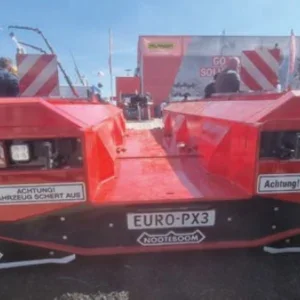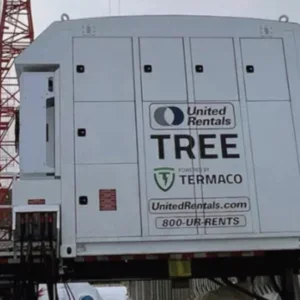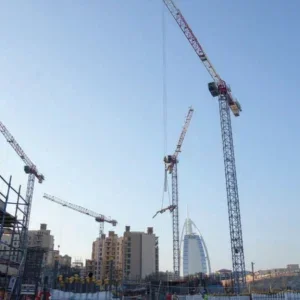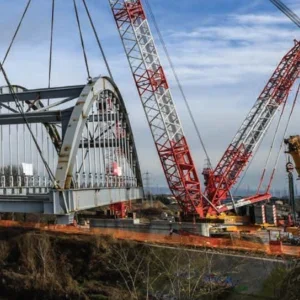Rising costs are hitting many European crane rental companies hard, with a fiercely competitive market making it difficult to pass on these costs to customers, according to Dimitri Rombouts, financial controller of Belgium-based Van Der Weghe.
He says that prices are coming under increasing pressure as the costs of labour, safety, and fuel rise. ‘Nowadays, because of tough market conditions, there is no relationship between the real cost, and what you can ask of the market. That means we have a difficult business, and the power is with the clients. It is they who determine prices.’
This year, Van Der Weghe plans to take delivery of 16 Grove all terrain cranes from 35t to 100t to replace 30 machines. “It is a replacement as well as a downsizing of our portfolio,’ Rombouts explains.
However, he believes the market in Belgium is beginning to recover as demand increases, especially as a result of rising investment in the petrochemical industry.
General construction too is gaining in strength, he says: ‘We are also in tower crane rental, and that is always where we see signs of recovery first. The demand for tower cranes is going up, and the mobile cranes will follow because they are the next step in the construction cycle. We predict 2005 will be better than 2004.’
Van Der Weghe’s tower crane fleet is 85 per cent occupied, and Rombouts does not plan to acquire more at present, although, he adds: ‘If we had the opportunity to buy some tower cranes second hand we would because it is too expensive to buy new tower cranes to be economic.’
Martin Ainscough, managing director of UK-based Ainscough Crane Hire, agrees that costs are a problem: ‘Business is probably a little bit tougher at the moment, but what we are really finding is that costs are increasing faster than our revenue,’ he says.
His main worry is the cost of fuel. ‘This continues to increase even in its present form, but the hottest issue at the moment in UK crane hire is that there is talk that the Government is going to try and take away our exemption to use red diesel.’
Mobile cranes are excepted from most of the tax on fuel in the UK provided they do not carry loads and use public roads. The rebated fuel is called ‘red diesel’. However, the British government is considering doing away with this exemption on cranes (See CT, February, page 47).
‘That,’ says Ainscough, ‘will put a phenomenal amount of cost on all crane companies. We estimate that it will be between £3 and £4 million in additional costs.’
However, labour costs are also marching upwards, he says. These increases, combined with ‘a little bit of a downturn in activity’, has made business ‘just a little bit tougher’.
Ainscough believes that cost increases are impossible to recover in the current trading environment. ‘It is always difficult in a fragmented industry, as the crane industry is, to pass increases across.’
A mixed picture is revealed in the US crane rental market with Jimmy Lomma of New Jersey-based Lomma claiming that business is ‘slightly down’ as people hold off on contracts. This, he says, has combined with major fuel cost increases of at least 35 per cent over the last year, and an increase in the cost of cranes because of steel price rises.
Crane rental companies also have to cope with supply problems as crane manufacturers often struggled to deliver. ‘I don’t believe they can get the equipment out fast enough because they can’t get the component parts, so most people have a six month backlog.’
However, Lomma expects to buy 10 or 15 new rough terrain and all-terrain cranes this year, and is upbeat about the future: ‘I think the recovery will take place in the third quarter of this year,’ he predicts.
Doug Williams of Buckner Heavy Lift Cranes in North Carolina, US believes business has already started its recovery: ‘From everything I have seen and am hearing I would expect it to continue to strengthen throughout the rest of the year. There are a lot of inquiries, and a lot of projects to bid.
‘I believe it is heading back in the direction it was two or three years ago where – at least for the larger cranes – getting the project depends mainly on availability. The market remains competitive, but having the right crane in the right place at the right time will determine who gets the work.’
For Williams, both industrial and commercial projects have picked up: ‘I think that is a sign of a more confident economy and market. Businesses are more optimistic, and are spending money again. Where we have seen the most growth is work in the power industries, and most of that relates to retrofitting emission reducing systems onto existing plant. The other growth area is wind turbine erection.’
Fuel and labour costs are not having a massive impact on Buckner’s business. A bigger concern is the price of steel, which is making cranes more expensive, and a weak dollar, which impacts on rental companies’ buying habits. ‘Equipment that would have previously come out of Europe is not as attractive. More recently, we have been buying more from the States than from Europe,’ says Williams.
He is lukewarm about future crane buying prospects. ‘Going through a slowdown tapers your desire to buy. I have talked to other large crane companies in the US, and I don’t see people buying as aggressively as they did before this slowdown because everybody stocked up on large crawler cranes [in the last construction boom].
‘In the crawler crane area, I believe everybody has a pretty strong inventory, and there is not as much of a need to do the kind of buying that was done five or six years ago.’
Buckner plans to buy two or three 60 to 80t telescopic cranes in the coming year as part of an upgrading process, ‘but so far as expanding goes, there is no great desire on our part to grow larger so our only other reason to buy is if the right project comes along where there is a demand we need to meet’.
Ron Schad, president and ceo of Essex Crane rental, has also seen an improvement in business recently. ‘There has,’ he claims, ‘been a period of excess capacity of cranes available, in particular in the power industry. However, we are seeing more power work, and a strengthening of the economy, and more construction projects are now using cranes.’
As for costs, he says there has been an increase in labour, fuel, and insurance costs. ‘But we have to absorb them – we haven’t been able to find ways to pass them on. Rental rates are depressed. We have to knuckle down and run as tight a ship as we can.’
Essex abandoned its long-held policy of buying only Manitowoc products by adding Liebherr duty cycle cranes to its fleet in July 2003.
According to Schad: ‘We are pleased with both manufacturers’ equipment. Our Liebherrs were really targeted – we went after a sector that needed lattice boom crawler cranes for heavy foundation construction and we specifically bought the Liebherr machines fitted that market better than other machines. That has been successful and we are hopeful we are going to be able to purchase more of those in the future.’
Bragg’s John Anderson agrees that business is good, putting it down to refinery rebuilding and windmill construction. ‘Business has probably grown by 9 per cent by value in the last year,’ he estimates.
Anderson says his company has not been hit particularly hard by cost increases: ‘Fuel costs fluctuate so much we have a standard surcharge for fuel and insurance of 4.5 per cent.’
Bragg has purchased two 240t Grove hydraulic cranes, four 80t Grove RTs, two 90t Grove RTs, and four 90t Link Belt hydraulic truck cranes. However, it also sold 40 cranes at auction in the last year, reducing the size of the fleet from 200 cranes to around 180.
Memphis, Tennessee-based Barhart serves the Eastern US, and Jeff Latture, the company’s senior vice president sales and marketing, says its business for the coming year looks better than for three years. ‘Our backlog is up significantly, and it is a pretty encouraging outlook for 2005 for us. The US economy has turned. Most of the companies that have been holding off on spending money on maintenance and upgrades over the last couple of years have enough confidence to go ahead with projects that have been on the table for a while.’
Environmental projects and expansion in the refining sector are, believes Latture, driving the economy. ‘There has been a lot of heavy lift work in the clean fuels programs in refineries in the US so it is a good time for companies again.’
Nonetheless, Barnhart has no specific plans for crane acquisitions. ‘We have sat pretty level for the last couple of years. I would see moderate purchases in mobile cranes – 60t and 70t truck cranes and maybe 200t class all terrains, but no major expansions – just moderate growth, updating the fleet,’ Latture says.






